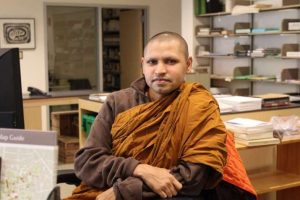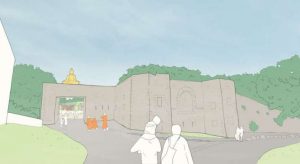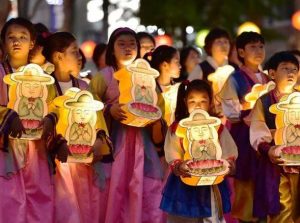Despite being the largest Buddhist denomination in Japan and the United States, Jodo Shinshu is generally little known in the West. Jodo Shinshu, sometimes called Shin Buddhism, is a school of Pure Land Buddhism that emphasizes attaining birth in the pure land of Amitabha Buddha (or Amida Buddha) through the “Buddha-invocation” (nianfo; nembutsu) of Amida alone. Philosophically, soteriologically, and theologically, this means that Amida alone takes salvific action (other-power), without the devotee technically undertaking any practice of their own (self-power). In addition to being the largest denomination in Japan and the US, Jodo Shinshu has long maintained a presence in Asia outside of Japan, including in Australasia, Canada, Latin America, and Europe.
Here, I make an effort to bring some attention to this influential school that has been neglected in our wider cultural awareness.
In September, I attended the 20th European Shin Buddhist Conference at the Eko House in Düsseldorf, in western Germany. The conference had been held every other year prior to the global spread of COVID-19, and this occasion marks the first time that the conference was convened since the advent of the pandemic.
I interviewed one of its priests, Reverend Marc Nottelmann, and our conversation explored the history of this remarkable temple.
The Eko House is a Shin Buddhist temple, the largest in Europe and only one built in the traditional style. Its name, eko, is taken from a passage in the Larger Amida Sutra and denotes “bestowing light” or the “luminous splendor” of Amida Buddha.
This year’s conference was held over two-and-a-half days. Priests and lay followers from across Europe as well as the Americas and Japan gathered to discuss the theme “Compassion and Practice in Jodo Shinshu.”
Each day opened with a short liturgy, followed by presentations from attendees. The first day commenced with a welcome speech from Prof. Dr. Hisao Matsumaru of the Eko House, opening remarks from His Eminence Koshin Ohtani, former monshu (head priest) of the Honganji-Ha denomination of Shin Buddhism (he is a direct descendant of the founder of Jodo Shinshu, Shinran Shonin), and a keynote speech from Rev. Kiyonobu Kuwahara.
A range of presentations then followed, discussing and analyzing various aspects of compassion from the specific perspective of Shin Buddhism. What kept the event fresh and engaging was the diversity of styles and approaches employed by different presenters. For example, some presentations (such as Rev. Prof. Enrique Galvan-Alvarez and Rev. Dr. Louella Matsunaga’s “Creating Compassionate Spaces: Ritual, Practice and Architecture in Jodo Shinshu” or Dr. Markus Rüsch’s “Jodo Shinshu” Practices in South Kyushu and Their Meaning in Defining Jodo Shinshu Orthodoxy”) were presentations of formal, scholarly research papers. Others, such as Dr. Prof. Xuan Phuc Nguyen’s “Born in the Pure Land–immediately or at the end of life?–A Journey of a Shin Buddhist” or Rev. David Quirke-Thornton’s “Chaplaincy in the UK from a Jodo Shinshu perspective” were more personal, autobiographical presentations.
Still others were more traditional, doctrinal expositions, such as Rev. Prof. Esho Sasaki’s “What is the “Great Compassion” in Shin Buddhism” and Rev. Ilona Evers’ “Compassion and Practice in Daily Life.” Perhaps most unusual was Rev. Diane Dunn’s “Poetry as Practice: Words Pointing Towards the Nembutsu,” which consisted mainly of readings of her late Dharma friend Marcus Cumberledge, Poet Laureate of Bruges, and her own equally wonderful poetry.
The conference also included “introductions” to various Shin Buddhist initiatives worldwide. The Buddhist Churches of America Centre for Buddhist Education introduced by Rev. Jerry K. Hirano, the Belgian temple Jiko-ji introduced by Mr. Alain De Preter and the online sangha “Jinen-ko” introduced by Rev. Prof. Enrique Galvan-Alvarez (see BDG’s interview with him here). A special panel on the translation of Jodo Shinshu texts was also included, wherein Rev. Dr. Takashi Miyaji, Rev. Dr. Jerome Ducor and Rev. Marc Nottelmann discussed the issues and challenges surrounding translating Shin Buddhist texts from Chinese and Japanese into English, French, and German.
The conference continued on the second day with a special anniversary service held in the temple’s main Buddha hall, where the chanting was accompanied by the beautiful melodies of traditional Japanese gagaku music. The conference concluded on the third day with a meeting to decide on the next European Shin Conference. It will be held in 2025 in Oxford, in the United Kingdom, on the theme of “Peace and Harmony.”
Interview with Rev. Marc Nottellmann
Buddhistdoor Global: Jodo Shinshu Buddhism has its roots in Japan. How did this particular tradition find its way to Germany?
Rev. Marc Nottelmann: Inspired by Arthur Schopenhauer and his philosophy, Nyanatiloka became a monk in 1902, and Paul Dahlke founded the “Buddhist House” in Berlin in 1924. Hence, in Germany since the beginning of the 20th century there has existed a small Theravada branch. Harry Pieper was member of the Buddhist House and later learned of Mahayana Buddhism from Angarika Govinda, a German who had lived in Tibet. In 1954, Pieper met the 23rd Monshu, Ôtani Kôshô, when he visited Germany and was so impressed by his personality and teaching that he founded the Buddhist Community Jodo Shinshu, Germany (Buddhistische Gemeinschaft Jodo Shinshu, Deutschland) in 1956.
BDG: Can you share the story of how the Eko House was founded in Germany? When was it built? Why was it built? And why in Düsseldorf? What is the objective of the Eko House? How was it financed?
RMN: The Eko House was founded by the entrepreneur Numata Ehan (or Yehan) (1897–1994), who was born in a Shin Buddhist temple family in Hiroshima. He studied abroad in Berkeley in the early 1920s, at which time he already wanted to propagate Buddhism in America by publishing a Buddhist magazine, but he failed for financial reasons. In 1934, he founded the company Mitutoyo, which produces measuring instruments. After his company had become economically successful he founded the renowned Bukkyo Dendo Kyokai (Society for the Promotion of Buddhism). During the 1980s, this association started its activities in Europe and in 1992 the Eko temple was consecrated and the Cultural Center started its activities. In the 1960s, Düsseldorf was the location of Mitutoyo’s European trading branch in the center of West Germany’s economy.
Since Düsseldorf is close to European metropoles such as Paris, London, and Bruxelles, many other Japanese companies settled in Düsseldorf. The Japanese population of Düsseldorf today is larger than in any other German town, and they have create a very visible subculture, for which Düsseldorf is famous. Numata Ehan saw the deep connection between Buddhism and Japanese culture. For him, Buddhism teaches the peaceful interrelation between all sentient beings, and therefore it is relevant for the multi-ethnic world of our time. He understood that nationality and race is of no concern, even as Numata grew older and his company even extended to Brazil (the country furthest from Japan).
We all have been brothers and sisters, and fathers and mothers in our past lives. As far as I know, Numata never expressed it explicitly, but I personally reckon that he chose Düsseldorf and not, for instance, Paris, because he felt that Germany and Japan had a deep historical relationship (and this relationship was a very negative one). To teach the ideal of kyosei (living together) was important especially in this country: Düsseldorf is only a few kilometers from Hitler’s tank factories. But, as I said, he never said anything explicitly about it.
BDG: The Eko House hosts various events. Can you share some examples of how these activities help people to connect with Shin Buddhism and its teachings? Aside from international events, do you have a local sangha at the Eko House? How many people are involved? Are they mostly from German, Japanese, or other ethnic backgrounds?
RMN: The Eko House offers all typical Japanese traditional arts (with the exception of martial arts): ikebana, shodô, playing the koto, dance, and more. And it is, of course, a place of traditional Buddhist ceremonies. The deepest contact with the Japanese population in Düsseldorf is the Eko Kindergarten, which has 30 German and 30 Japanese children. Many parents bring their children to the Shosanshiki (first temple visit ceremony). Some older Japanese people come more or less regularly to temple services, but younger Japanese we see rarely. The program of the EKO house is usually not a reason for people to become Shin Buddhists.
Even Zen Buddhism can make only slight gains from, for example, inspirations by shodô (shodō, or calligraphy, is heavily bound up with Zen Buddhism in Japan). It cannot be explained in brief, why the idea “interest in Japanese culture” leads to “becoming a Buddhist in a Japanese tradition” does not work, and why it is difficult to create a Japanese-German Buddhist community. I have published an article on this topic: “EKŌ-JI: Numata Ehan’s Ideas and Their Realization in a Japanese Buddhist Temple in Germany,” in Nottelmann-Feil, Marc, Journal of Religion in Japan, Vol. 11, No. 1 (2022). And even in this in-depth article, I did not have space to discuss the underlying problems, which are intimately tied up with the history of Western Buddhism.
BDG: Eko-ji is extremely distinctive. Who designed it? Was there a specific influence architecturally, such as a specific temple in Japan or a particular era?
RMN: The construction company, Suzuki Kensetsu, erected the temple and the other buildings. It was a cooperation between Japanese and German workers. Numata Ehan donated the same temple in Utsunomiya, Ibaraki-ken.
BDG: The Eko House has a beautiful Japanese garden. Who designed it? Can you explain the significance of the garden and its role in the temple’s activities?
RMN: The same construction company was responsible, but I would have to pick up the names of the gardener in a certain book (which I don’t have available at the moment). More important is that it is a combination of a Pure Land Garden and an aristocratic villa style garden (shinden-zukuri), and this form can be traced back to Kyoto of the Heian era (although, as far as I know, no garden of that era survived to present days). As a temple garden, people are not allowed to play there or to have an o-hanami picnic there. However, in the warm months of the year, before the coronavirus, we used to have once a year a spring/summer/autumn festival: in the center of the garden a stage was erected where dancers, musicians, martial artists, and so on demonstrated their arts.
BDG: Temples often serve as cultural hubs. How has the Eko House contributed to the cultural exchange between Japan and Germany?
RMN: There are many cases which demonstrate the meaning of the Eko-House as cultural hub. In 2005 the former president of Germany, Horst Köhler, and the minister president of North Rhine Westphalia visited the Eko House, as well as German and Japanese economic representatives. But true cultural exchange happens in daily life. I now hear the voices of the Japanese and German children of the kindergarten who are playing together.
BDG: Over the years, have you witnessed any unique or heartwarming stories of transformation or deepening of faith among followers?
RMN: There are many stories of people, but transformation is often an invisible process. People get more open and clear-eyed when they grow older. I remember, for example, a certain member, Richard Hastreiter, who lived in Bavaria, southern Germany, and came to our hoonko seminars in autumn. He was a friendly and silent type of man. I heard that he died sitting in front of his Buddha altar. His wife found him there with a peaceful face in the early morning. I always wish that I also will have a peaceful death in this way.
Anyone interested in attending and/or presenting at the 2025 conference may contact Rev. Dr. Louella Kaishin Matsunaga at [email protected].
Related features from BDG
Sangha Luso-Hispana Jinen-kô: An Online Shin Buddhist Community
Swiss Shin: Reverend Ducor and Switzerland’s Only Shin Buddhist Temple
Related news from BDG
Jodo Shinshu Buddhist Temple in Hawaiʻi Confronts Declining Attendance
















